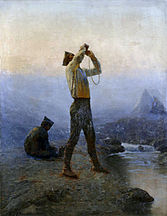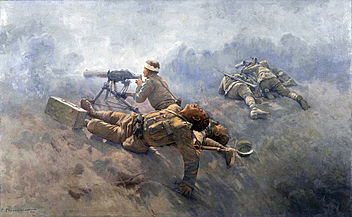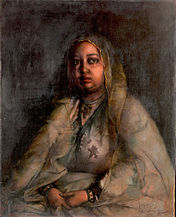Georgios Prokopiou
Georgios Prokopiou ( Greek Γεώργιος Προκοπίου ; * 1876 in Izmir ; † December 20, 1940 near Tepelena ) was a Greek war painter , photographer and documentary filmmaker. From 1905 to 1907 he was court artist of the Ethiopian Emperor Menelik II.
Life
Not much is known about Prokopiou's youth and family. At the age of 15 he was an icon painter and the English artist Hortense Wood , who lived near Izmir, discovered the boy's talent. She gave him drawing lessons and showed the work to the painter and art professor Nikiforos Lytras , who recommended Prokopiou to the Athens School of Fine Arts . Prokopiou enrolled in 1895 and studied with Lytras and Georgios Roilos . After completing his studies, he returned to Izmir in 1901 and showed his works in a first exhibition. Two years later he traveled to Alexandria and Cairo , where he painted portraits of distinguished Greeks. Among them was the officer Pavlos Melas , who introduced him to the head of the diplomatic corps of Ethiopia.
This encounter led to an invitation to Addis Ababa to portray Emperor Menelik II. He traveled with a caravan from Djibouti to Adis Ababa. He was accompanied by his brother Socrates, who later wrote a book about the trip. Prokopiou prevailed in a competition with other artists and was appointed court painter in 1905. After portraits of the imperial family, he also painted several ambassadors, but also landscapes and village scenes. The painter was not only well paid, but also received the Order of the Seal of Solomon and the Order of the Star of Ethiopia from the Emperor .
In 1907 Georgios Prokopiou returned to Athens and married Lula Fasili there, with whom he had two sons, Andreas and Angelos. In the following years he traveled a lot until he settled in Izmir in 1913. At the beginning of the First World War , Izmir was blocked by the Allies. Soon after, the Ottomans began persecuting Christians. Most of the Greek population, including Prokopiou and his family, hid or fled. Nevertheless, he found work as an art teacher for the daughter of an Ottoman official, which gave him protection. At this time he created his first art of war. They were depictions of naval operations in the Dardanelles campaign.
After the First World War, Izmir came under Greek control. General Leonidas Paraskevopoulos commissioned Prokopiou with paintings, photos and films of the Greek campaigns against the Turks in the Greco-Turkish War . Although commanders admired his courage, some complained that his activities interfered with military operations. After the capture of Izmir by Turkish troops in 1922, he returned to Izmir. In the same year he photographed the fire in Izmir .
Shortly afterwards he was arrested and sentenced to death by a Turkish court. However, the prison commandant allowed him to say goodbye to his family. With the help of his neighbors and the French consul, he and his family escaped aboard a French ship that was taking them to Piraeus . In 1925 he settled in Athens. He continued to paint military scenes until 1928, after which he produced a variety of nudes, scenes of ruins and portraits, including one of Haile Selassie , who had visited his studio shortly before he became emperor.
The Greco-Italian War began in 1940 when Greece refused to surrender to the Axis powers . Although Prokopiou was 64 years old and had bronchitis, he went to the War Department and asked to be sent to the front. Finally, he wrote to Prime Minister Ioannis Metaxas that he was ashamed to stay home when his two sons were fighting for Greece. Metaxas agreed to his request and Prokopiou traveled to Albania to join the Greek counter-offensive. There he met his son Angelos and immediately began to draw and take photos. Prokopiou died of heart failure on the night of December 20, 1940. He received the posthumous rank of colonel, was returned to Athens and buried with full military honors.
painting
Empress Taytu Betul
Web links
Individual evidence
- ↑ a b Georgios Prokopiou. Archived from the original on March 11, 2014 ; accessed on April 7, 2020 .
- ↑ a b c Biographical ΓΙΩΡΓΟΣ ΠΡΟΚΟΠΙΟΥ: Ενας Ελληνας στην αυλή του βασιλιά της Αβησσυνίας , To Vima , December 17, 2010, accessed April 8, 2020
- ↑ Προκοπίου Γεώργιος (1876 Μπουρνόβα Σμύρνης - 1940 Αργυρόκαστρο). National Gallery of Greece, archived from the original on April 3, 2016 ; accessed on April 8, 2020 .
- ↑ a b c short biography. In: Istoria. Archived from the original on June 3, 2008 ; accessed on April 8, 2020 .
- ↑ a b Georgios Prokopiou , Pemptousia, accessed April 8, 2020
| personal data | |
|---|---|
| SURNAME | Prokopiou, Georgios |
| BRIEF DESCRIPTION | Greek war painter, photographer and documentary filmmaker |
| DATE OF BIRTH | 1876 |
| PLACE OF BIRTH | Izmir |
| DATE OF DEATH | December 20, 1940 |
| Place of death | at Tepelena |





